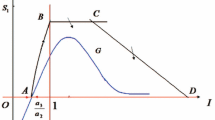Abstract
In this paper, a mathematical model for the entomopathogenic nematode attacking the pest is investigated. This novel theoretical framework could result in an objective criterion on how to release the entomopathogenic nematode in order to control the pest population under the economic threshold (ET) which indicates the maximally admissible pest densities. Firstly, continuous release of the entomopathogenic nematode is taken. By using qualitative analysis method, the sufficient condition of the global stability of the positive equilibria and the existence and uniqueness of limit cycle of the system are obtained. Secondly, impulsive release of the entomopathogenic nematode is also considered. Using the Floquet’s theorem and small-amplitude perturbation, we obtain that the pest-free periodic solution is locally stable if some conditions are satisfied. In a certain limiting case, it is shown that a nontrivial periodic solution emerges via a supercritical bifurcation. Finally, our findings are confirmed by means of numerical simulations.
Similar content being viewed by others
References
Bhatnagar, V.K.: Pesticides pollution: Trends and perspectives. ICMR Bull. 31, 87–88 (2001)
Rekha, S.N., Naik, R., Prasad, R.: Pesticide residue in organic and conventional food Crisk analysis. Chem. Heal. Saf. 13, 12–19 (2006)
FAO, Proceedings of the Asia Regional Workshop, Regional office for Asia and the Pacific, Thailand, 26–28 July 2005
Agoramoorthy, G.: Can India meet the increasing food demand by 2020? Futures (in press). doi:10.1016/j.futures.2007.10.008
Agnihotri, N.P.: Pesticide Safety and Monitoring. All India Coordinated Research Project on Pesticides Residues, Indian Council of Agricultural Research, New Delhi, India, 1999
Gelernter, W.D., Trumble, J.T.: Factors in the success and failure of microbial insecticides in vegetable crops. Integr. Pest Manag. Rev. 4, 301–306 (1999)
Chandler, D., Davidson, G., Grant, W.P., Greaves, J., Tatchell, G.M.: Microbial biopesticides for integrated crop management: an assessment of environmental and regulatory sustainability. Trends Food Sci. Technol. 19, 275–283 (2008)
Koppenhöer, A.M., Fuzy, E.M.: Long-term effects and persistence of Steinernema scarabaei applied for suppression of Anomala orientalis (Coleoptera: Scarabaeidae). Biol. Control 48, 63–72 (2009)
Lopes, C., Spataro, T., Lapchin, L., Arditi, R.: Optimal release strategies for the biological control of aphids in melon greenhouses. Biol. Control 48, 12–21 (2009)
Hawkins, B.A., Cornell, H.V.: Theoretical Approaches to Biological Control. Cambridge University Press, Cambridge (1999), p. 412
Bedding, R.A., Akhurst, R.J., Kaya, H.K.: Future prospects for entomogenous and entomopathogenic nematodes. In: Bedding, R.A., Akhurst, R.J., Kaya, H.K. (eds.) Nematodes and the Biological Control of Insect Pests, pp. 157–170. CSIRO Publications, Melbourne (1993)
Ehlers, R.-U.: Current and future use of nematodes in biocontrol: Practice and commercial aspects in regard to regulatory policies. Biocontrol. Sci. Technol. 6, 303–316 (1996)
Ehlers, R.-U., Hokkanen, H.M.T.: Insect biocontrol with non-endemic entomopathogenic nematodes (Steinernema and Heterorhabditis spp.): Conclusions and recommendations of a combined OECD and COST workshop on scientific and regulatory policy issues. Biocontrol. Sci. Technol. 6, 291–293 (1996)
Woodring, J.L., Kaya, H.K.: Steinernematid and Heterohabditid Nematodes: A Handbook of Techniques. Southern Cooperative Series Bulletin 331. Southern Regional Project S-135: Entomopathogens for Use in Pest-Management Systems. J. Econ. Entomol. 93(4), 1105–1108 (2000)
Zhang, Z., Ding, T.R., Huang, W.Z.: Qualitative Theory of Differential Equations. Translations of Mathematical Monographs, vol. 101. Am. Math. Soc., Providence (1992)
Bainov, D.D., Simeonov, P.S.: Impulsive Differential Equations: Periodic Solutions and Applications. Pitman Monographs and Surveys in Pure and Applied Mathematics. Pitman, London (1993)
Lakshmikantham, V., Bainov, D.D., Simeonov, P.S.: Theory of Impulsive Differential Equations. World Scientific, Singapore (1989)
Zhang, H., Georgescu, P., Chen, L.S.: An impulsive predator–prey system with Beddington–Deangelis functional response and time delay. Int. J. Biomath. (IJB) 1, 1–17 (2008)
Author information
Authors and Affiliations
Corresponding author
Additional information
This work is supported by the National Natural Science Foundation of China (No. 10771179).
Rights and permissions
About this article
Cite this article
Wang, T., Chen, L. Dynamic complexity of microbial pesticide model. Nonlinear Dyn 58, 539–552 (2009). https://doi.org/10.1007/s11071-009-9499-7
Received:
Accepted:
Published:
Issue Date:
DOI: https://doi.org/10.1007/s11071-009-9499-7




